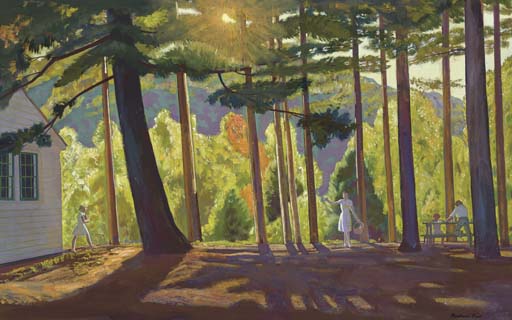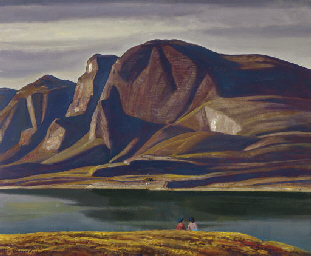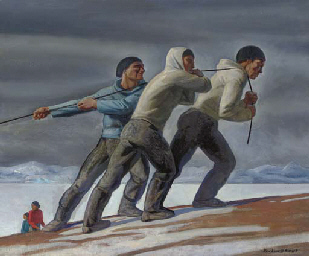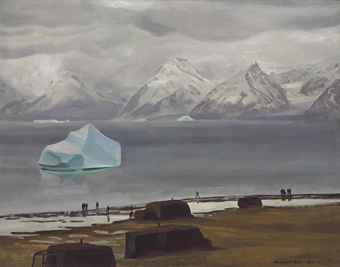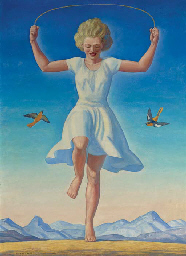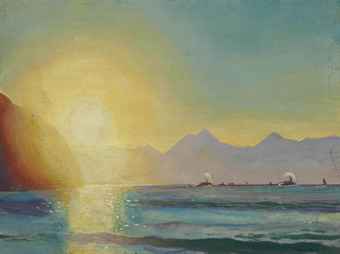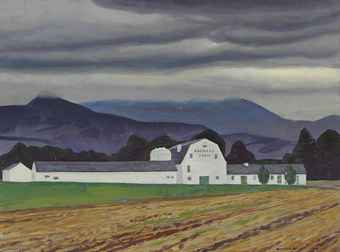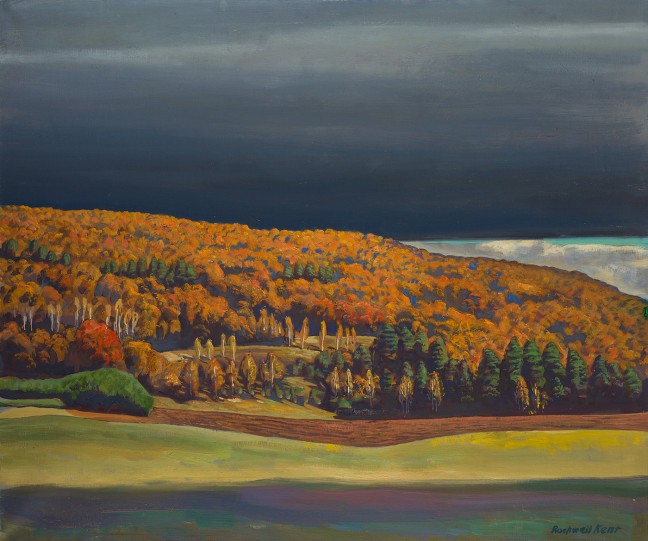Biography - Questroyal Fine Art, LLC, New York, New York
By Amy SpencerAt the height of his career Kent was one of the most famous painters in America as well as a renowned printmaker and illustrator.
I. Biography
II. Chronology
I. Biography
Rockwell Kent, an adventuresome and multitalented artist, pursued many interests during his long and active life. He traveled extensively, from the northern locales of Greenland and Alaska to the southern tip of South America, all the time writing, sketching, and painting veraciously. He was also well-known for his illustration work and was a prolific printmaker. Today his works are collected by every major American museum, including the Art Institute of Chicago, Los Angeles County Museum of Art, Metropolitan Museum of Art, and National Gallery of Art.
Rockwell Kent was born in Tarrytown, New York on June 21, 1882. His father was a successful lawyer and his early years were spent between affluent homes in Manhattan, Long Island, and the Hudson River Valley. In 1887 his father died from typhoid; his mother then raised Kent and his two siblings dependent on charity from wealthy relations. Kent’s aunt, an accomplished ceramics painter, came to live with the family and when Kent was thirteen she took him on a trip to Europe, which undoubtedly opened his wanderlust for exploring the world.
Kent attended the Cheshire Academy in New York and then enrolled in the Horace Mann School where he studied mechanical drawing and woodworking. During this time Kent assisted his aunt in painting and selling her ceramic and chinaware. Later in life Kent would design his own dinnerware.
In the summer of 1900 Kent enrolled in William Merritt Chase’s School of Art at Shinnecock, Southampton, Long Island. Kent excelled at the school and was offered a full scholarship to Chase’s New York School of Art (now Parsons The New School for Design). Unfortunately, Kent’s financial circumstances precluded a career in the fine arts and in the fall of 1900, at the urging of his mother, he began classes at the School of Architecture at Columbia College (now Columbia University).
Kent briefly worked as an architectural illustrator while studying at Columbia; however, before graduating, he decided to risk everything and return to studying art. In 1903 he enrolled in the New York School of Art where he received instruction from Robert Henri and Kenneth Hayes Miller. Among his fellow students were George Bellows and Edward Hopper. While at the New York School Kent’s aunt introduced him to the eccentric painter Abbott Thayer, who hired Kent as a summer apprentice at his Dublin, New Hampshire studio in 1903. Thayer’s naturalist lifestyle and almost mystical appreciation for natural phenomena had a great impression on Kent; he returned to Dublin for many years to visit Thayer and his family. Kent eventually married Thayer’s niece, Kathleen Whiting, in 1908 and the couple had five children.
During the summer of 1905 Kent visited Monhegan Island off the southern coast of Maine. He fell in love with the place and returned the following year, building a house for himself on Horn’s Hill. Kent spent the next several years living his summers and winters on Monhegan, working as an assistant teamster, longshoreman, and well driller. During this period he painted some of his most dynamic coastlines, contrasting turbulent sea and sky with abstract forms of rocks and cliffs. Kent had his first one-person show of Monhegan paintings at New York’s William Clausen Gallery in 1907.
Kent’s adventures next took him and his young family to Brigus, Newfoundland from 1914 to 1915. Kent intended to set up an art school in Brigus; unfortunately Kent’s public love for German culture––he would often sing German songs in public–– caused much unease amongst local residents on the eve of World War I. Eventually, Kent was exiled from the colony on the suspicion he might be a spy.
Loving northern climates, Kent next spent eight months in Alaska from 1918 to 1919, living with his young son in a small cabin on Fox Island in Resurrection Bay. Kent painted by day and drew by lamplight at night. He also began developing his skills as a wood-engraver. As well as depicting the physical power of nature, themes such as loneliness, isolation, and martyrdom emerged in his work.
In 1920 Kent published his first book of letters, which he wrote while in Alaska, titled Wilderness. The same year his Alaskan drawings and paintings where shown in two exhibitions at Knoedler’s in New York. A critic of the New York Times wrote of the exhibition, “Mr. Kent has found the thin air of the north stimulating to his poetic intelligence. He thinks more profoundly, sees more clearly, and gives his imagination more vigorous play than when he painted in a different latitude.”1 The success of Kent’s Alaska paintings brought him his first taste of fame and financial security.
Kent settled his family on Egypt Farm in Arlington, Vermont in 1919 before, in 1922, impulsively setting off alone for Tierra del Fuego, an archipelago off the southernmost tip of the South American mainland. While traveling around the archipelago, Kent hiked across Brecknock Pass and attempted to sail around the Horn in a converted lifeboat. He returned home from these adventures and exhibited his resulting paintings at Wildenstein Gallery in 1924.
Kent divorced his first wife in 1925 and the following year married Frances Lee. Kent and his second wife settled on a farm near Au Sable Forks, New York. Naming the place Asgaard Farm, they built a large house and opened a dairy business. Though he spent a great deal of time on the farm––it was his home for the remainder of his life––Kent continued to travel. Between 1925 and 1928 he visited France and Ireland, and in 1929 visited Denmark and Greenland. Kent returned to Greenland in 1931–32 and 1934–35. In Greenland Kent fell in love with the indigenous peoples’ way of life and created many sympathetic images of them.
By the 1930s Kent increasingly accepted more commercial illustration assignments. Some of the most successful books he illustrated included Herman Melville’s Moby Dick (1930), Chaucer’s The Canterbury Tales (1934), Walt Whitman’s Leaves of Grass (1936), and The Complete Works of Shakespeare (1936). He also took on projects for companies like General Electric, Rolls Royce, and Westinghouse. In 1937 Kent was commissioned by the Federal Public Works Administration to create two murals for the post office in Washington, DC.
After his final trip to Greenland, Kent was one of the most popular artists in America; however, this all changed during the 1940s. Now in his sixties, Kent traveled less and spent most of his time at Asgaard Farm. He continued to paint, but more of his time was occupied by his interest in politics. He divorced Frances Lee in 1940 and married Sally Johnstone, who was his junior by more than thirty years. The same year Kent wrote and illustrated This Is My Own, a semi-autobiographical book that outlined his thoughts on socialism and recent activities on behalf of various labor and peace causes. The book was immediately controversial as it criticized America’s foreign policy leading up to the country’s entrance into World War II.
In 1953, because of his interest in promoting friendship between America and the former Soviet Union, Kent was investigated by Senator McCarthy’s Committee on Un-American Activities. His overseas travel was also restricted. The Committee found Kent not to be a communist and, following a lawsuit, his passport was reinstated in 1958. Despite these small victories, Kent effectively became a persona non grata in America as his art was shunned from galleries and museums for the remainder of his life. In retaliation for his homeland’s rejection, Kent gave eighty paintings and many illustrations to the former Soviet Union in 1960 where he continued to be popular. During the last decade of his life Kent became the first American to have his work exhibited in the former Soviet Union and he was given the Lenin Peace Prize in 1967.
In 1969 Kent’s Au Sable Forks home was struck by lightening and most of its contents were destroyed. Though eighty-seven years old at the time he immediately drew up plans for rebuilding. The house was completely rebuilt and refurnished before he died of a heart attack on March 13, 1971. He was buried on Asgaard Farm.
II. Chronology
1882 Rockwell Kent is born in Tarrytown, New York, on June 21 and is raised in an affluent family moving between their multiple homes in Manhattan, Long Island, and the Hudson River Valley
1887 Father, Rockwell Kent Sr., dies
1894–1896 Studies at Cheshire Academy
1895 At age thirteen, an aunt, who is a ceramic artist, takes him on a tour of Europe
1896 Attends Horace Mann School
1900 Spends summer in painting classes at William Merritt Chase’s Shinnecock School in Southampton, Long Island (also in 1901 and 1902)
1900–1902 Studies architecture at Columbia University; however, towards the end of his degree, decides to pursue a career as an artist
1904 Enrolls in the New York School of Art, alongside George Bellows and Edward Hoppers, where his teachers include Chase, Robert Henri and Kenneth Hayes Miller
Meets Rufus Weeks and attends first Socialist meeting
1905 Abbott Thayer hires Kent as his summer assistant at his New Hampshire studio
Visits Monhegan Island, off the southern coast of Maine, upon the recommendation of mentor Robert Henri
1907 Has first one-man show at the William Clausen Gallery in New York
1908 Marries Abbott Thayer’s niece, Kathleen Whiting, with whom he has five children
Joins the Socialist Party
1909 Birth of first son, Rockwell III
1910 Runs the Monhegan Summer School of Art
1911 Helps organize a show for the Society of Beaux Arts Architects in Manhattan, where he meets and befriends painter Marsden Hartley
Birth of first daughter, Kathleen
1912 Moves to Winona, Minnesota
1913 Birth of daughter, Clara
1914–1915 Lives in Newfoundland
1915 Birth of daughter Barbara
1917 Serves as full time organizer and administer of Independent Exhibition
1918 Duncan Phillips, founder of The Phillips Collection in Washington, DC, begins acquiring Kent’s paintings
1918–1919 Visits Alaska with eldest son
1919 Purchases Egypt Farm, Arlington, Vermont
1920 Publishes and illustrates Wilderness: A Journal of Quiet Adventure in Alaska
Birth of Son, Gordon
1922 Travels to Tierra del Fuego, Chile
1924 Publishes and illustrates Voyaging: Southward from the Strait of Magellan
1925 Takes a trip to France
Divorces Kathleen Whiting
Phillips offers Kent a stipend of three hundred dollars a month in return for the first selection of two paintings each year (Kent only accepts this offer for one year)
1926 Marries Frances Lee
Visits Ireland
1927 Purchases Asgaard Farm, a dairy farm near Au Sable Forks, New York
Works as editor of Creative Art
Helps organize National Gallery of Contemporary Art in Washington, DC
1929 Visits Greenland
1930 Illustrates Herman Melville’s Moby Dick
Publishes N by E
1931–1933 Returns to Greenland
1934 Illustrates Chaucer’s The Canterbury Tales
1934–1935 Final trip to Greenland
Publishes Salamina
1936 Travels to Puerto Rico
Illustrates Voltaire’s Candide, Walt Whitman’s Leaves of Grass, and The Complete Works of Shakespeare
1937 Travels to Brazil
1937–38 Commissioned by the Federal Public Works Administration to create two murals for the newly built post office in Washington, DC
1939 Divorces Frances Lee
Creates Mural for General Electric at New York World’s Fair
1940 Publishes This Is My Own
Marries Shirley (Sally) Johnstone, his junior by over thirty years
1946 Elected to Executive Committee of the American Labor Party
Publishes and illustrates To thee! A toast in celebration of a century of opportunity and accomplishment in America, 1847–1947
1948 Is Congressional candidate for the American Labor Party
Transfers ownership of dairy to remaining employees after boycott resulting from his support of the Progressive Party’s Henry Wallace for president
1949 Attends World Congress for Peace in Paris
1950s Art is shunned by galleries and museums across America because of his leftist ideology and perceived un-American support for the Soviet Union
1950–1958 Denied U.S. passport; a lawsuit and appeals to the Supreme Court results in the reinstatement of Kent’s right to travel
1953 Testifies before the House Committee on Un-American Activities
1955 Publishes and illustrates It’s me, O Lord; the autobiography of Rockwell Kent
1958 Has one man show at the Hermitage Museum in Leningrad
1959 Publishes Of Men and Mountains
1960 In defiance of his homeland’s rebuff, Kent gifts a large part of his collection to the Friendship House in Moscow
Exhibits at the Pushkin Museum in Moscow
1963 Publishes Greenland Journal
1966 Elected to the Academy of Arts of the U.S.S.R.
1967 Awarded the Lenin Peace Price in Moscow
1969 Home at Au Sable Forks is destroyed by a fire
Papers that survive the fire are donated to the Archives of American Art
1971 Dies of a heart attack on March 13, in Plattsburgh, New York, and is buried on Asgaard Farm
Sotheby’s 2017
Six months after establishing an auction record for the artist with Gray Day, Sotheby’s presents its highly important pendant, Blue Day, Greenland (estimate $400/600,000). Painted during the artist’s third and final trip to Greenland, Blue Day, Greenland was illustrated on the cover of Kent’s autobiography – a statement of its importance within the artist’s oeuvre. Exhibited widely across the United States, and in Russia, the painting has been held in a private collection since its purchase at Sotheby’s in 2003. Sotheby’s October3 2013
ROCKWELL KENT
ALASKA IMPRESSION
LOT SOLD. 43,750
ROCKWELL KENT
1882 - 1971
1882 - 1971
TIERRA DEL FUEGO, SOUTH AMERICA [DOME MOUNTAIN]
LOT SOLD. 206,500
Estimate 40,000 — 60,000
Lot Sold 46,875
Estimate 20,000 — 30,000
Lot Sold 56,250
Estimate 8,000 — 12,000
Swann 2010
Swann 2010
- ROCKWELL KENTLandscapeEstimate $3,000 - $5,000Price Realized (with Buyer's Premium) $6,240
Swann 2005
- ROCKWELL KENTStarlightEstimate $3,000 - $5,000Price Realized (with Buyer's Premium) $9,000
- ROCKWELL KENTThe BatherEstimate $2,000 - $3,000Price Realized (with Buyer's Premium) $4,320
- ROCKWELL KENTMan at MastEstimate $1,500 - $2,500Price Realized (with Buyer's Premium) $2,990
Swann 2004
- ROCKWELL KENTDon JuanEstimate $1,000 - $1,500Price Realized (with Buyer's Premium) $1,840
Swann 2003
- ROCKWELL KENTSt. Johns, New Foundland.Estimate $1,000 - $1,500Price Realized (with Buyer's Premium) $4,140
- ROCKWELL KENT The Creation of Man.Estimate $4,000 - $6,000Price Realized (with Buyer's Premium) $3,680
- ROCKWELL KENT Music play your merriest tune!.Estimate $2,000 - $3,000Price Realized (with Buyer's Premium) $2,760
- ROCKWELL KENT Embracing Couple.Estimate $1,000 - $1,500Price Realized (with Buyer's Premium) $2,530
Spring Thaw, Greenland
PRICE REALIZED
$68,750
Girl Jumping Rope
PRICE REALIZED
$58,600
Killer Whales in Resurrection Bay, Alaska (Whales)
PRICE REALIZED
$52,500
Asgaard Farm
PRICE REALIZED
















